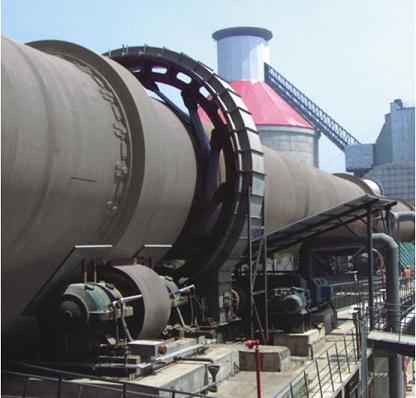The material after being roughly homogeneous in the limestone deposit, the clay is shoveled into the conveyor head into the mill head by the bucket. Additional auxiliary materials are also discharged from the tank down the conveyors along the mill. Here the mixture of raw materials is put into the dryer, which is spread by the fertilizer and bucket to the hot air stream, the material mixture is dried at 280 - 350oC before moving to the compartment. At the mixing chamber, the material is crushed and scrubbed to the required size. At the end of the mill a small fraction of the dust flows through the Sepax separator, some of the fine dust coming through the fine particles that fall through the hole into the air intake, onto the bucket, and down to the feeder into the Sepax separator. .
The coarse particles will return to the grinder, the fine particles reaching the required size in airflow to the two cyclones. The pulp after the 2 cyclones settles through the troughs of the aerodynamic lift to the height of the trough to the silo where the material is initially homogeneous in the silo by compressed air prior to the furnace.

From the same silos, the powder is disassembled according to the installation program. The removal program is shown through homogeneous process by removing multiple locations on a plane by compressed air systems.
The pulp is discharged to the troughs, through the drain valves. The raw material is put into the collecting box and then down to the cage and then unloaded onto the loading screw, through the engine valves and the gas valve and simultaneously compressed from the bottom of the compressed air. The screw is fed to the feeder, which feeds the feed to the tube connecting the top and bottom cyclones through the flap valve and the flip valve.
Here the powder is heated by hot air from the furnace, which pushes the powder into the top-level cyclone in the direction of the top-down helix, the material splashes into the cyclone, loses energy to the bottom of the cyclone and passes through the discharge valve to the tube. Between the 2nd and 3rd floor cyclones, the exhaust gas is ventilated to the cooling tower and then into the electrostatic precipitator.
The heat exchange between the meal and the hot air continues through the cyclone layers until the powder enters the fourth floor of the cyclone. The powder is divided into 2 branches by the control valve, Distribute 40% of the raw material into the blown chamber and 60% of the raw material into the calciner decomposer. Under the effect of the nozzle temperature along with the exhaust gas of the furnace entering the calciner bottom in axial direction in conjunction with the 3 airflow away from the clinker cooler, the mixture is highly carbonated, then pushed into the cyclone before The furnace must reach 90-95% of the total amount of decomposed carbonate.
When the material is carbonated in the calciner, it is pushed to the fifth floor cyclone into the furnace. Under the rotational effect with the slope from 3 to 4 ° C of the furnace is transferred through the zones in the furnace is clustered at 1300 - 1400oC, then to form clinker people cool quickly 1300-1100oC with staging Recording chillers, high-pressure fans and chilled water. The clinker meets the requirements to fall straight down the bucket, while the clinker blocks have not yet been delivered to the conveyor to the pre-hammer to the required size down the bucket. pour into the scoop, transport into the clinker silage.
The clinker kiln system is a dry kiln system, the material is fired at a temperature of about 1,450oC. The clinker is cooled at the IKN refrigeration register of Germany, with optimum gas dispersion pressure for optimum cooling to produce the best quality clinker.
The system is fully equipped with automation control and monitoring of the running process.
Infrared emitting system.
Furnace analysis system.
System for measuring the parameters of heat, pressure.
Flame monitoring system for flame head, refrigeration and rotary kiln control devices.
Duyen Ha cement